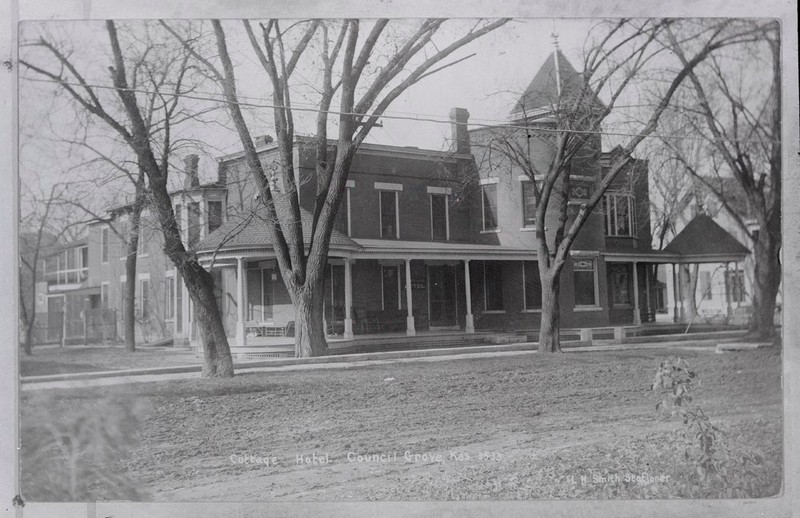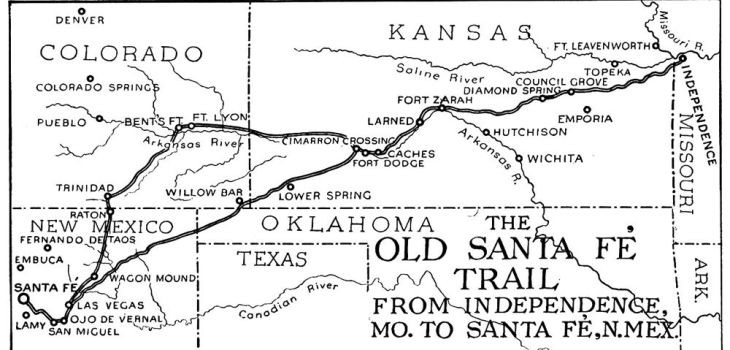The Cottage House Hotel
Introduction
Text-to-speech Audio
What started as a three-room cottage and Blacksmith shop in 1867 has grown into a landmark hotel that has served Council Grove for more than a century. A series of additions, notably the 5,000-square-foot Queen Anne structure that was added in 1898, has allowed the property to grow into one of the landmarks of the city with a guest list that speaks to the town's history. The hotel initially served raveling salesmen and businessmen during the late-nineteenth-century along with a large family that moved west from Michigan. Council Grove was part of the Grand Prairie Highway (Santa Fe Trail) and on Highway 56 (and close to Interstates), leading to the operation of a roadside motel in the years of auto travel prior to the construction of interstate highways. Today, the hotel's victorian appearance has been restored and it operates as a historically-themed hotel similar to a bed-and-breakfast.
Images
1960s photo of The Cottage House Hotel from the Kansas Historical Society

The Cottage House Hotel
.jpg)
Council Grove existed as a spot on the Grand Prairie Trail as part of the Santa Fe Trail

Backstory and Context
Text-to-speech Audio
The Cottage House resulted from several buildings and additions constructed over a period from roughly 1867 to the 1890s, with wings and additions erected as late as 1914. The Cottage House served two principal purposes in its first few decades: providing housing and entertaining for Lewis Mead's business associates and a gathering place and home to the many members of the Marks family. But, because the town also served as a significant spot along the Santa Fe Trail, guests often stayed there, too.
The hotel enjoyed humble beginnings as a three-room cottage and Blacksmith shop, built in 1867 by George Biglin. In 1871, the Reverend and Mrs. Joab Spencer bought the property and subsequently built a two-story brick house engulfing the cottage. The Spencers sold the house in 1879 to Mr. and Mrs. Lewis Mead. The historic building provided a comfortable means of entertaining and housing for Mead's numerous business contacts and associates. A few of his business associates stayed at the hotel on a long-term basis and developed their own private enterprises, while others, such as traveling salesmen or "drummers," stayed only a day or two. Meanwhile, the Cottage House also provided a unique and close-knit environment for the many members of the Marks family, all of whom had emigrated to Council Grove from Moscow, Michigan, between 1869 and 1884. Some of the Marks family lived in the hotel, while others lived in a house across the street. However, they all dined together at the hotel. Still, while the Cottage House mainly served Mead and the Marks family, it also catered to travelers (notably traveling business people), not as a hotel but as a type of boarding house.
The Cottage House grew in many stages, demonstrated by the various design styles of each segment. In 1897, the Mead family purchased the two-story, brick Italianate "cube" house built in 1871 or 1872. The cube engulfed a three-room cottage dating back to 1867. In 1898, The Mead family erected a 5,000-square-foot Queen Anne addition to the Cottage House, which marks the house's transition into a hotel. Unlike most hotels of the time, the Cottage House offered guests a home-like atmosphere; the rooms appeared like spare bedrooms of one's house, and the dining area resembled one's dining room (akin to today's bed & breakfast hotel model in appearance).
Although the hotel gradually lost some of its allure after Lewis Mead's death in 1924, Josephine Mead operated the Cottage House until she died in 1932. In 1934 the hotel was sold at a Sheriff's sale to the Bratton family, who owned the property until 1960. Although they mainly rented single rooms and apartments, the Braxton family did lease the site to the U.S. Government in 1943 to provide housing for staff at Delavan Air Base. In 1960 the hotel was sold again and became known as the Stagecoach Motor-Tel, which speaks to the rise of automobiles and highways that allowed people to traverse the nation.
When new owners purchased the property in 1982, they restored the interior woodwork and floor plan and reclaimed the Cottage House Hotel name. Today, the historic Cottage House functions as a unique hotel. Its presence serves as a reminder of the town's connection to its early history, two early families that helped settle Council Grove, its place along the Santa Fe Trail -- Great Prairie Highway, and later the growing U.S. Highway system.
Sources
"The Cottage House Hotel and Motel." Kansas. TravelKS.com. Accessed July 14, 2021. https://www.travelks.com/listing/the-cottage-house-hotel-and-motel/2701/.
Epperson, Jason. "The Great Prarie Highway." National Parks Podcasts. January 4, 2020. https://nationalparkpodcast.com/the-great-prarie-highway/.
Hagedorn, Martha. "Nomination Form: Cottage House Hotel." National Register of Historic Places. nps.gov. 1988. https://npgallery.nps.gov/GetAsset/114422ba-c62a-436d-98d2-1e063c745869.
Rothman, Hal K. Devil's Bargins: Tourism in the Twentieth-Century American West. Lawrence: University Press of Kansas, 1998
https://www.kshs.org/km/items/view/316846
By Douglas Kulp - City between the Ages, CC BY 2.0, https://commons.wikimedia.org/w/index.php?curid=36303156
https://nationalparkpodcast.com/the-great-prarie-highway/

